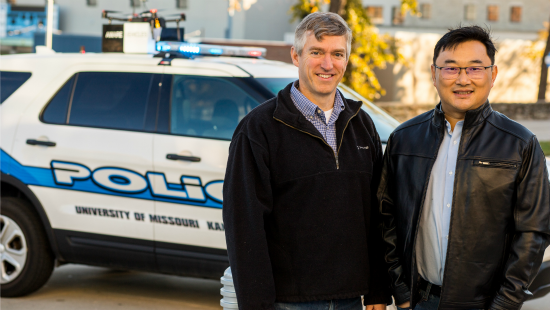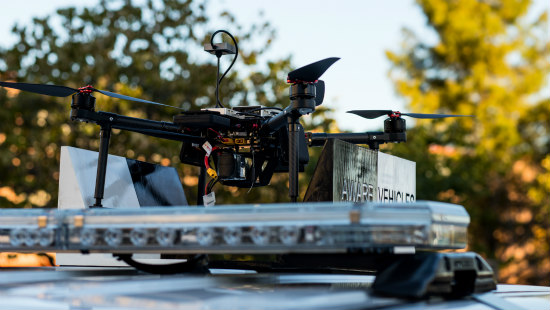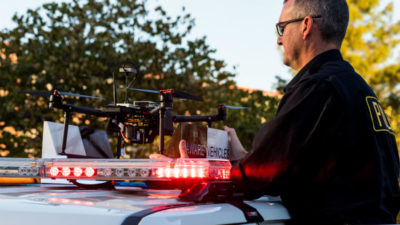Aware Vehicles, UMKC partner to develop Unmanned Aerial Vehicle automation
Imagine an autonomous drone taking off from a smart docking station on top of a moving vehicle, navigated only by GPS and cameras, collecting and transmitting data and landing right back same place it took off from. Pretty cool, right? Impossible? Not anymore.
University of Missouri-Kansas City Associate Professor of Civil and Mechanical Engineering ZhiQiang Chen, PhD, in partnership with Aware Vehicles President and CEO PJ Piper, recently received funding from the National Science Foundation — $225,000 – and the U.S. Department of Transportation — $150,000 – to develop unmanned aerial vehicle automation, sensing and artificial intelligence technologies that will be prototyped into systems for precision agriculture and civil infrastructure sectors.

How Does It Work?
Aware Vehicles is working to create systems that make drones more autonomous and less reliant on human input. Chen said that while getting the drone to take off is easily done with the flip of a switch, the hardest part of this project is getting it to self-pilot and land back on the docking station. However, an autonomous drone is just half of a product because, Piper said, it still has to do something.
With the help of Chen’s hyperspectral imaging expertise, the drone will be able use advanced imaging equipment to collect data in real time and translate information back to the computing devices in the ground vehicles.
Hyperspectral imaging collects and processes information from across the electromagnetic spectrum with the goal of obtaining the spectrum for each pixel in the image of a scene. The purpose for this type of imaging is to find objects, identify materials or detect processes.
“We’ve been looking at the interests of various government agencies to see what they’re looking for and how our technology can help solve those particular issues.”
PJ Piper, President and CEO of Aware Vehicles
The team was fortunate to receive two awards within a year – National Science Foundation and a Small Business Innovation Research grant from the Department of Transportation – to help develop and test their systems in real life applications in precision agriculture and civil infrastructure.
This type of equipment also has the potential to work in fields such as homeland security and military defense, construction, parcel delivery – imagine an Amazon-type delivery system – and disaster response.

Photo – courtesy of Aware Vehicles
Real life application: Precision agriculture
The concept for precision agriculture is to get better information from advanced imaging.
The team is currently working with large agriculture original equipment manufacturers to integrate drone and tractor technology systems for real time situational awareness to solve farmers’ pain points.
“Challenges that didn’t have solutions, we are finding elegant solutions to and trying to keep it as minimalistic as possible.”
– Piper
The autonomous drones with hyperspectral imaging will be able to analyze groups of plants in specific locations and identify, based on wavelengths of light, which plants need more or less water, fertilizer or pesticide chemicals.
“Scientists do this all the time in labs. It’s called phenotyping, but they can’t do it in the field. How would they be able to translate such a large amount of data?”
– ZhiQiang Chen, PhD, associate professor of civil and mechanical engineering
Problem solved. The information collected from the drone’s imaging system will be translated back to its mobile smart docking station, which crunches the data and tells the tractor what to do. Based on its GPS location, the tractor can determine which treatments to deliver to specific field areas all autonomously.
“Its real time situational awareness,” Chen said.
They’re also working to apply this to civil infrastructure – bridges and highways.

Bridge Inspection
There are only a handful of people who are able to assess when bridges should be replaced, you can’t take them everywhere, and cities can’t shut down highways to have them inspected. The team is working with the U.S. Department of Transportation to develop the capability for someone to pull up and park their vehicle and allow an autonomous vehicle to fly over, collect data and translate it back to the department in real time without their experts having to drive across the state to do that.
Chen said there a lot of people who talk about using drones for bridge inspection, but there’s always the hassle of having to get out of your vehicle and fly the drone around for a few minutes before having to go back and charge it. With the Aware Vehicles smart docking station, the drone will be pre-programmed to know where the bridge is and where to look so the department doesn’t need an experienced operator to be there.
The team is using the funding from their grant awards to complete development and will begin demonstrations within the next six months to a year.

